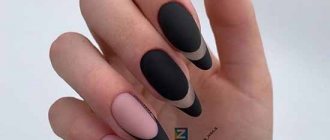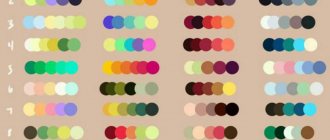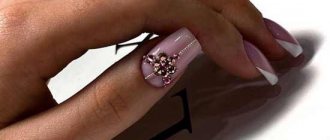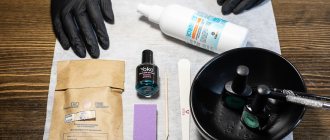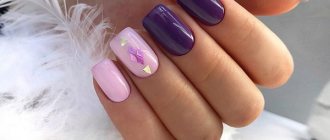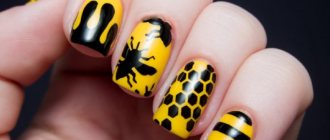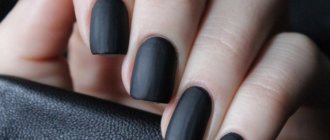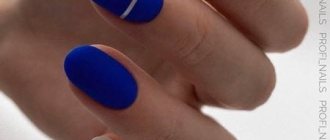Types of forms and their features
Natural nails can have different appearances depending on individual characteristics. At the same time, not all women are satisfied with the shape of their plates and want to correct it to a more aesthetic one.
There are the following types of nails depending on their shape:
- Square - sharp tips form a straight line, while the entire nail plate has approximately the same dimensions in length and width. It is considered a safe form that helps avoid deformation.
- Soft square shape - unlike classic square nails, this type has a smooth rounding at the very edges. This type is contraindicated if the skin ridges on the sides are too prominent.
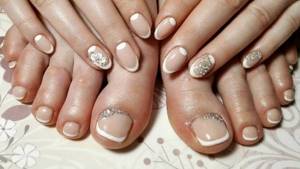
- The rocker arm is an even more rounded square; only the central part will remain straight, occupying ⅓ of the length of the entire plate. When creating this shape, you should wait until the ends grow a little.

- Fully rounded - this type of nails is not so common. Usually this form occurs in men, but women can also remove the edges on their own, completely smoothing them out.
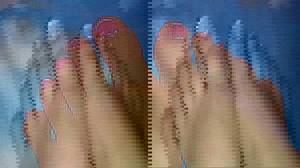
- Oval pedicure is a combination of a rounded edge and a long base.
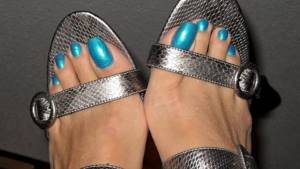
- In the shape of a trapezoid , the plate in the area of the cuticle is significantly narrower in width than in the area of the ends. This type is usually of natural origin.
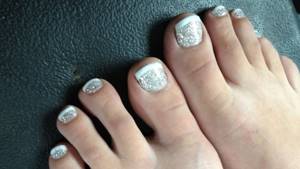
- Rectangular - straight, even edges with significantly elongated nails.

- Arched nails are a separate type of rectangular or square shape with an arched edge.
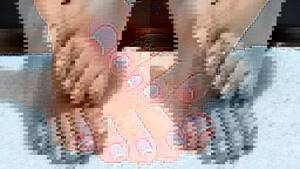
The presented nail forms can be found on natural plates or created on artificial nails. Choosing the right appearance of your nails is an excellent prevention against ingrown nails.
Varieties of beautiful toenail shapes
• The most popular nail shape is oval. The nail is elongated and is a continuation of the cuticle line. This shape can often be seen on the fingers.
• Pointed. It is one of the most difficult techniques to perform. “Sharp claws” are loved by confident, eccentric women. It is very rarely done on the legs.
• Rectangular. Elongated nail, top cut with right angles. Performed during manicure and pedicure.
• Round. All lines are smooth and rounded. Length is short. It is not often seen on toenails.
• Square. Like rectangular, only short length. It is most common on the legs.

How to fix a nail plate?
The shape of your nails directly affects the health of your entire foot. Quite often, in the presence of convex side ridges, square plates can be subject to corner ingrowth, and also lead to complete deformation of the nail. In this case, it is worth achieving rounded edges and carefully monitoring the length.
The opposite situation also occurs, when excessively oval plates prevent the formation of edges in the area of flat rollers. This condition is also a risk for ingrown toenails. In order to correct the nail plate, it is necessary to perform a set of hygienic and cosmetic measures:
- To give the desired shape, use nippers or files, and then be sure to grind and polish your nails. In case of dry and brittle plates, use a machine with soft and medium abrasive cutters. It is better not to use hard attachments, as they can split the edges. You can also cut your nails with scissors, but this method is only suitable for thin plates.
- To get the perfect shape, use the nail extension procedure with gel polish or acrylic. In this case, you can create any shape, even if the natural plates do not have a very beautiful appearance.
- Steam your feet regularly and remove hardened epidermis with a pumice stone. The ideal remedy for baths is chamomile decoction, sea salt and lemon oil.
- Apply moisturizer at night.
- Try to wear tight shoes less often.
- During a pedicure, do not forget about removing the cuticle. This will make the nail look longer and more harmonious.
- If you have thin nails, rub oils or a special nourishing cream into them.
- Watch the length of your nails. You should not grow the ends too long, or cut them off excessively. It is important that the nail overcomes the ingrowth zone on its own.
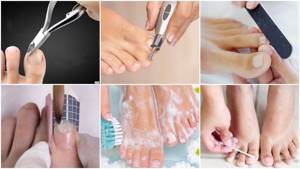
Mechanical correction can significantly change the shape of the nails, but maintaining it cannot be done without hygienic procedures. If the plates are affected by fungus or inflammation, it is necessary to first carry out a course of treatment.
Master class on pedicure
Tags: nails
Market Analytics
- Global cosmetics market 2021: an unprecedented test for the global cosmetics industry
- Top 10 Cosmetic Research and Development of 2021
- 2020 in the beauty industry – innovation without borders
Convenient search for beauty salons on our website
Beauty salons in Moscow Beauty salons in St. Petersburg Beauty salons in Ekaterinburg Beauty salons in Novosibirsk
Latest blog posts on our website
- Naturecream / “Sugar” wrinkles - or what glycation can do
- Naturecream / Esterified oils
- Naturecream / Arnica - the magical plant of alchemists
- Naturecream / Tremella Extract - Snow Mushroom Detox for Skin
- Prostye-sovety / How to visually enlarge your lips with makeup
- Naturecream / Apricot kernel oil for face
- Naturecream / MATRIXYL3000 - the best skin elasticity stimulator
- Naturecream / SPF in Natural Oils
- Naturecream / Geranium (Pelargonium) oil for skin health and beauty
- Prostye-sovety / Save on a beauty salon: procedures that can be done at home
Latest forum topics on our website
- Natalya / How to properly make a gelatin mask?
- Mrs._Smith / Badly sunburned! What to do?((
- Ice / Is it necessary to combine fitness classes with a diet?
- Antonova / What can be used for hair loss?
- Radio operatorKat / Who was on a protein diet?
Other articles in this section
| Manicure with the effect of broken glass Manicure with the effect of broken glass will allow your own imagination to run wild, since it has many options for nail design. Manicure “Broken glass” is now in trend. |
| Manicure on short nails Fashion trends in manicure today favor short nails. Just a few years ago, preference was given to long, well-groomed nails: they were carefully nourished and grown or lengthened in other ways, without neglecting the extension of nail plates using acrylic or gel. Today, natural manicure is popular, and caring for it is much easier. |
| Hardware manicure Hardware manicure is a way to tidy up your nails without using cutting tools. The method is an excellent alternative to trimmed manicure, especially if the nails are problematic or deformed. |
| Hardware pedicure Every day our feet are exposed to a lot of physical activity. This especially applies to women and girls who prefer high heels and narrow shoes. When wearing uncomfortable shoes for a long time, you need to pay sufficient attention to the health of your feet. One of the ways to help restore the normal condition of the feet is a hardware pedicure. |
| Men's pedicure A few years ago, when asking men for their opinion about pedicure, almost every second one answered that it was some kind of female procedure. But the situation is changing, and men's pedicure is no longer exotic. |
| How to choose and make the right nail shape The choice of nail shape directly depends on the shape of the cuticle edge and the length of the nail plate. A manicure can look completely different in each case. Choosing the shape of your nails is like choosing a silhouette in clothes: it will help hide imperfections, visually lengthen your nails, or vice versa, make your hands coarser and your fingers shorter. |
| Manicure with foil Nail design options are very diverse. One of the most original techniques with a wide range of design options is decorating nails with foil. This nail art is very impressive, noticeable and immediately attracts attention to its owner. And you don’t have to be a professional to do it. The necessary materials, instructions, a little practice - and you will succeed. |
| European unedged manicure An unedged manicure is a cosmetic nail care procedure that differs from a classic trimmed manicure in that the thin skin of the nail cuticle is not cut, but is moved and removed using special products containing fruit or lactic acid. Read our article about how unedged manicure is performed (it is also called European), what products and tools are needed for it. |
| French manicure French manicure is a universal nail design suitable for any outfit and occasion. French, like no other type of manicure, can make your hands well-groomed, graceful and neat. Read about the history of French manicure, its types and methods of execution in our article. |
| Nail design Nail design is a modern type of aesthetic cosmetology that favorably emphasizes the beauty of women's hands, and also allows you to hide minor imperfections. The history of nail art dates back to Ancient China, where high-status fashionistas grew their nails up to 25 cm long and put tips on top to avoid damaging them. |
How to give the correct round shape?
Despite the fact that oval and rounded ends on nails are considered somewhat out of fashion, in some situations this option looks much more appropriate than square plates.
The easiest way to achieve a perfect round shape:
- Spread your legs in the bath.
- Using scissors or clippers, shorten the overgrown part of the nail to an optimal length equal to approximately 2 mm from the area where the plate departs from the skin.
- File the plates with rounded cutters. Use rollers to round the central part of the nail, and use small diamond balls to remove the pointed corners. The use of shelves is allowed.
- Remove the cuticle. You can simply move it with a stick to the root zone of the nail bed, but most masters prefer to completely trim the cuticle.
- Sand the surface and then inspect it carefully.
- Degrease the plates, then begin to carefully apply clear varnish. You can leave it as is, or apply the desired design over the base.
This scheme is suitable for implementation after the extension procedure. Artificial tips are easy to grind and hold well despite their short length.
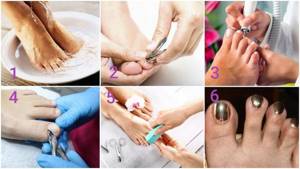
Step-by-step method for making toenails rounder
Bath recipes
Treatment of an ingrown toenail with folk remedies involves several types of drugs, which differ in the method of application. One of them is the use of medicinal herbs and some products for local water procedures.
- A bath of baking soda and salt helps soften the skin around an ingrown toenail. It is necessary to mix 100 g of salt and 50 g of soda in a small basin, pour hot water over this mixture. The water temperature should be approximately 39-40 °C to achieve a steaming effect, but without causing burns to inflamed tissues. The bath lasts 10 minutes.
- A bath with chamomile will help reduce inflammation and relieve swelling. To prepare it, 9 tbsp. l. Pour 3 liters of boiling water over dried chamomile flowers, let it brew for an hour, then strain. The solution is used for baths, heated to a comfortable temperature.
- Baths with St. John's wort herb have an antiseptic and healing effect. Pour 10 tbsp into a saucepan with 2 liters of boiling water. l. dried crushed St. John's wort and leave for 30 minutes in a water bath, then strain. The infusion can be used for local foot baths.
In addition to baths, it is advisable to wash your feet several times a day in warm soapy water and also wipe them dry. Throughout the day, it is important to keep your feet clean and sweat less.
How to make square nails?
A classic pedicure is usually always accompanied by giving the nails an even shape. A square nail is less likely to grow into the nail folds and looks more natural.
In order to make such nails, you must follow this technique:
- Take a warm foot bath.
- Remove dead skin around nails and remove or move cuticles.
- File the nail plates with cutters or a stick strictly in a straight line. Perform all movements only perpendicular to the length of the nails so as not to touch the corners.
- Treat the plates with an antiseptic, and then begin applying the base varnish.
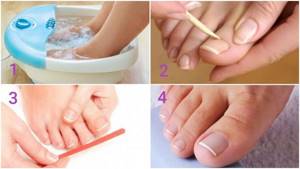
Often, when reproducing a square shape, the plates visually expand. This can be compensated for by the length of the nails, which should be slightly extended above the line of the finger.
Congenital anonychia
The cause of congenital anonychia is rare hereditary anomalies or serious defects of embryonic development. Sometimes the disease is passed on from generation to generation. The mode of inheritance of anonychia is often autosomal recessive.
The disease can be combined with other problems of the outer layer of the skin, sweat, sebaceous glands, disruption of the hair structure and other developmental defects. Or not be accompanied by any more deviations. In all other respects the child will be healthy.
The congenital anomaly is associated with a defect in the development of the ectoderm - the outer germ layer of the embryo. The nervous system, tooth enamel, and eye lens are formed from the ectoderm. As well as the epithelial integuments of the body, skin, nails, hair, sebaceous and sweat glands. Congenital anonychia is associated with ichthyosis, a hereditary disorder of keratinization of the skin.
Anonychia of the nails can be one of the manifestations of syndromes affecting several parts of the body. These include Grob-Siris syndrome, nail-patella syndrome, and hypohidrotic ectodermal dysplasia.
It has been established that the cause of congenital abnormalities in the formation of the nail plate is a mutation in the RSPO4 gene, which encodes the synthesis of the R-spondin-4 protein. This protein is involved in the formation of limbs, especially at the ends of the fingers and toes where nail development occurs. A mutation in the gene leads to the fact that the synthesized protein does not have the necessary functions.
During embryonic development, the formation of the nail plate in the fetus occurs gradually in the 3-5th month of pregnancy. First, seals form at the site of future nails, which then transform into the rudiments of the growth zone of the matrix. Instead of a nail, with congenital anonychia, the child develops ordinary skin, like around the nail plate, or a shapeless horny mass.
For an example of what the symptoms of anonychia look like, look at the photo:
Design features for different shapes
For those who want to show off the perfect pedicure, it is important not only to choose the ideal type of nail plates, but also to be able to find the right design for them.
Some interesting ideas include the following:
- A dark shade of varnish will look especially good on a rounded pedicure. The “cat’s eye” technique looks interesting on such plates.

Round nail shape and dark polish
- The optimal basis for creating a classic French manicure is square nails and a soft square shape. The design of the white tip can be made either in an arc or strictly even.

French pedicure on square nails
- Pastel coatings harmonize well with smooth square and rounded plates.
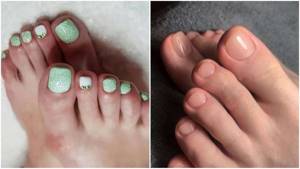
Light pedicure on nails with rounded corners
- Decorating round and oval nails with light designs and colorless rhinestones is becoming increasingly popular. This design looks interesting in combination with bright colors.

Round pedicure patterns
- Many people loved the matte black pedicure, especially in combination with a rocker or rectangle shape.
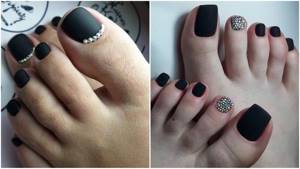
Matte black pedicure on rectangular nails
- Raspberry shades look great on oval nails, as well as plates with rounded corners.

Competent individual selection of shape is the key to healthy nail plates, which directly affects the aesthetic side of the design. A beautiful nail outline will make any pedicure fashionable and modern, and will also attract the attention of others.
Types of treatment for onychomycosis infection
At the initial stage of a fungal infection, a dermatologist may prescribe local treatment with drugs, i.e. applied locally in the form of cream and varnish; first make an appointment for nail cleaning with a podiatrist.
If more than 1/3 of the nail is affected by pathogenic dermatophyte fungi, systemic treatment is prescribed in the form of regular cleaning of the nail plates in the podiatrist’s office, topical preparations and oral preparations (orally).
Alas, there are exceptions when patients diagnosed with onychomycosis cannot be prescribed systemic treatment due to a concomitant number of chronic diseases, but even in this case, podological cleansing is recommended.
In all the cases described above, in addition to treatment, a conservative technique can be used - photodynamic antimicrobial therapy. The procedure itself is simple and safe to use, which can be used in a podiatrist’s treatment room.
Symptoms, stages of the disease and complications
An ingrown toenail has several stages of the disease, each of which has its own symptoms.
1. At the initial stage, swelling of the soft tissues around the nail occurs, severe redness of the skin is observed, after which their color gradually changes to bluish. The pain, which first appears when you press on the nail (while walking and changing shoes), later becomes permanent.
2. At the second stage, an inflammatory process develops. In areas where infection accumulates, pus begins to form, and the pain becomes pulsating.
3. The third stage is characterized by excessive tissue growth (pathological granulations) on the side where the nail plate adjoins the skin. In response to infection, so-called “wild meat” appears in this area, often accompanied by ulcers and strong discharge of pus. All this indicates that the disease has reached a chronic stage.
Self-treatment of an ingrown toenail at home can only be carried out in the initial stages, when there is no pus yet. At an advanced stage, you should immediately consult a doctor.
Diabetes mellitus and atherosclerosis of the vessels of the legs can contribute to the development of complications with ingrown toenails. These diseases lead to disruption of normal blood supply to the feet, which reduces the ability of tissues to regenerate and resist inflammatory processes. Complications that arise from an ingrown toenail include:
- lymphadenitis (lymphangitis) – inflammation of blood vessels and lymph nodes
- finger abscess – swelling, redness and suppuration (requires surgical intervention)
- osteomyelitis - spread of pus to the bones (this diagnosis is made after an X-ray examination and may require amputation of a finger)
- gangrene - an irreversible process of tissue necrosis, accompanied by their blackening (requires partial or complete amputation of the finger)


